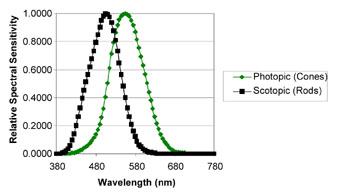Optipedia • SPIE Press books opened for your reference.
Photopic V(λ) and Scotopic V′(λ) Response
Excerpt from Field Guide to Visual and Ophthalmic Optics
The human visual system does not respond uniformly to all wavelengths in the visible spectrum. It is most responsive in the middle portion of the spectrum and less responsive for red and blue wavelengths. Furthermore, the two classes of photoreceptors, the rods and cones, have different spectral response curves.

Under photopic conditions, the rods are saturated and only the cones are producing a visual signal. Under scotopic conditions, the light levels are too low to activate the cones, but the rods still respond. Mesopic conditions refer to the in-between state where both rods and cones are active.
| Lighting Condition | Luminance (cd/m2) |
| Photopic | >3 |
| Mesopic | 0.03–3 |
| Scotopic | <0.03 |
The peak of the photopic curve occurs at a wavelength of 555 nm. The peak shifts to a wavelength of 505 nm for scotopic conditions. This shift in sensitivity towards the blue end of the spectrum in dim illumination is called the Purkinje shift. A table of values for V(λ) and V'(λ) can be found in the Appendix. The Commission Internationale de l’Eclairage (CIE) defined V(λ) as a standard in 1924. However, more recent studies have demonstrated that this curve is too low for wavelengths less than 460 nm. Judd, Vos, and Stockman have made corrections to this curve.
J. Schwiegerling, Field Guide to Visual and Ophthalmic Optics, SPIE Press, Bellingham, WA (2004).
View SPIE terms of use.


